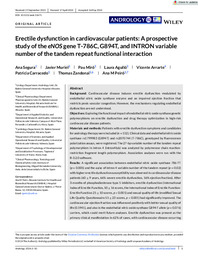Title:
Erectile dysfunction in cardiovascular patients: A prospective study of the eNOS gene T-786C, G894T, and INTRONvariable number of the tandem repeat functional interaction |
Authors:
Segura, Ana 
Muriel, Javier 
Miró, Pau
Agulló, Laura 
Arrarte, Vicente
CARRACEDO, PATRICIA 
Zandonai, Thomas
Peiró, Ana  |
Editor:
Wiley |
Department:
Departamentos de la UMH::Farmacología, Pediatría y Química Orgánica |
Issue Date:
2024-05-16 |
URI:
https://hdl.handle.net/11000/32546 |
Abstract:
Background: Cardiovascular disease induces erectile dysfunction modulated by endothelial nitric oxide synthase enzyme and an impaired ejection fraction that restricts penis vascular congestion. However, the mechanisms regulating endothelial dysfunction are not understood.
Objectives: Exploring the functional impact of endothelial nitric oxide synthase genetic polymorphisms on erectile dysfunction and drug therapy optimization in high-risk cardiovascular disease patients.
Materials and methods: Patients with erectile dysfunction symptoms and candidates for andrology therapy were included (n=112).Clinical data and endothelial nitric oxide synthase rs1799983 (G894T) and rs2070744 (T-786C), genotyped by fluorescence polarization assays, were registered. The 27-bp variable number of the tandem repeat polymorphism in intron 4 (intron4b/a) was analyzed by polymerase chain reactionrestriction
fragment length polymorphism. Association analyses were run with the R-3.2.0 software.
Results: A significant association between endothelial nitric oxide synthase 786-TT (p = 0.005) and the aa/ac of intron 4 variable number of the tandem repeat (p = 0.02) with higher erectile dysfunction susceptibility was observed in cardiovascular disease patients (60 ± 9 years, 66% severe erectile dysfunction, 56% ejection fraction). After 3-months of phosphodiesterase type 5 inhibitors, erectile dysfunction (International
Index of Erectile Function, 50 ± 16 scores, the International Index of Erectile Function- Erectile Function 21 ± 10 scores, p < 0.001) and sexual quality of life (modified Sexual Life Quality Questionnaire 55 ± 23 scores, p < 0.001) had significantly improved. The cardiovascular ejection fraction was influenced positively with better sexual quality of life (0.1941), and also in the endothelial nitric oxide synthase G894-T allele (p = 0.076)
carriers, which could merit future analyses. Erectile dysfunction was present as the primary clinical manifestation in 62% of cases, with cardiovascular disease occurring concurrently. Only former smokers and obese subjects debuted prior to cardiovascular disease than to erectile dysfunction.
Conclusions: Our study provides comprehensive insights into the functional interaction linking endothelial nitric oxide synthase gene polymorphisms, erectile function, and ejection fraction in high-risk cardiovascular disease patients. Future therapeutic strategies could target endothelial nitric oxide synthase activity by including lifestyle changes and epigenetic modulations.
|
Keywords/Subjects:
cardiovascular diseases
eNOS gene
erectile dysfunction
pharmacogenetics |
Knowledge area:
CDU: Ciencias aplicadas: Medicina: Farmacología. Terapéutica. Toxicología. Radiología |
Type of document:
info:eu-repo/semantics/article |
Access rights:
info:eu-repo/semantics/openAccess |
DOI:
https://doi.org/10.1111/andr.13671 |
Published in:
Andrology. 2024 Jul 1 |
Appears in Collections:
Artículos - Farmacología, Pediatría y Química Orgánica
|

.png)
